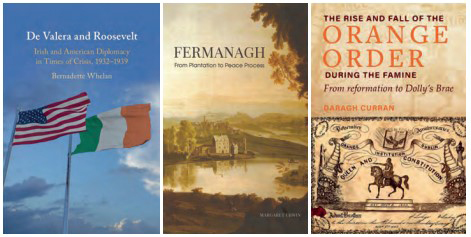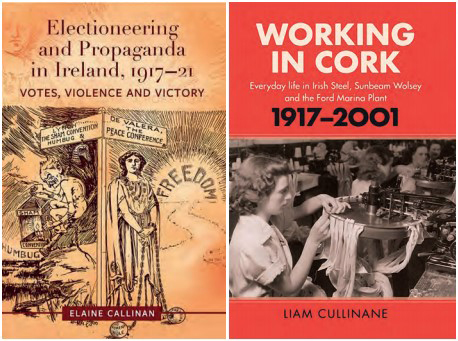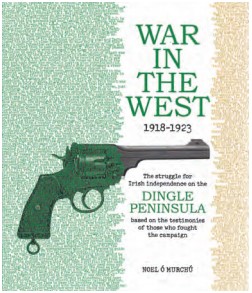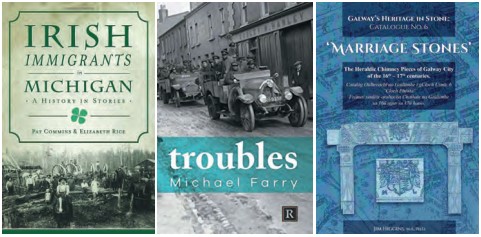BOOKWORM
Published in Book Reviews, Book Reviews, Issue 3 (May/June 2021), Volume 29Joe Culley
@TheRealCulls
In De Valera and Roosevelt: Irish and American diplomacy in times of crisis, 1932–1939, Bernadette Whelan takes a close look at both the formal and informal efforts to build an understanding between our still-nascent state and the world power. One significant conclusion that Whelan reaches is identifying Dev’s blind spot: ‘… de Valera’s mistaken belief in the importance of Irish concerns to a Democratic administration … For both sets of diplomats, the American–British “special relationship” was the most important factor in the American–Irish relationship and not the reverse as de Valera mistakenly believed, which was the flaw in his US policy.’
Whelan’s prose is clear and free of jargon but, given the academic nature of the publication, it inevitably lacks a certain verve. There must be some quite colourful tales surrounding the attempts to build ‘soft power’ through friendly socialising—or, to put it simply, I want more gossip and scandal. For example, I’d like to hear more about the Abbey Theatre tours to the States, and of the consequent objections from the United Irish Societies of New York to the displays of ‘filthy language, drunkenness and prostitution’ in productions of the plays of Synge and O’Casey.
Whelan has spent much of her career studying Irish–US relations and is a current editor with the RIA’s Documents on Irish Foreign Policy. This is a significant contribution to the field.
 In Fermanagh: from plantation to peace process Margaret Urwin examines the several reasons why that county was ‘a place apart’ during the recent conflict. For example, 87% of the 115 ‘conflict-related’ deaths there between 1972 and 1994 are attributed to the IRA—a much higher percentage than in the neighbouring counties. This is largely because loyalist murders there stopped in 1975 and never resumed.
In Fermanagh: from plantation to peace process Margaret Urwin examines the several reasons why that county was ‘a place apart’ during the recent conflict. For example, 87% of the 115 ‘conflict-related’ deaths there between 1972 and 1994 are attributed to the IRA—a much higher percentage than in the neighbouring counties. This is largely because loyalist murders there stopped in 1975 and never resumed.
Urwin has worked with the Pat Finucane Centre for Human Rights/Justice for the Forgotten for many years. Here, using declassified documents acquired through the Historical Enquiries Team, she details the violent incidents in which the 115 victims died, and examines some of the greater and often-contested themes of the conflict there. For example, the county’s unionist and Protestant communities often felt as if they were being singled out for special treatment.
Urwin, however, does not find evidence to support claims of ‘ethnic cleansing’, though of course that doesn’t change the perception. And while she finds no evidence that the police south of the Border did not cooperate with their northern counterparts, it is clear that the British authorities made little effort to provide the south with information about loyalist attacks. It is Urwin’s hope that a dispassionate examination of the past can assist in the attempts to reconcile the two communities.
The Orange Order ceased to exist—officially—in 1836, under pressure from a government that was attempting to assuage Catholic demands in order to stave off further agitation. As Daragh Curran explains, however, in The rise and fall of the Orange Order during the Famine years: from reformation to Dolly’s Brae, the order did not disappear; while the élite at its head may have stepped down, it continued to thrive at local level, particularly among the ‘lower classes’. Although the question of tenants’ rights moved some Protestants to dabble with the idea of an alliance with Catholics, the Orange parades, processions and celebrations continued, and the order’s core membership clung to their traditions. The rebellion of 1848 galvanised the Protestants again and the order earned a new authority, but a year later a fatal clash between an Orange march and Ribbonmen in County Down—which the marchers ‘won’—led to another government crackdown.

From the same Four Courts stable as Curran’s book—and with a cover design so similar one assumes it is deliberate—comes Electioneering and propaganda in Ireland, 1917–21: votes, violence and victory by Carlow College lecturer Elaine Callinan. As the jacket blurb puts it, ‘Callinan places her study within the wider contexts of the modernization of propaganda during the Great War and the expansion of consumerism to conduct an examination of election activity—from candidate selection and fundraising to door-to-door canvassing, and everything in between. Running alongside war and revolution were the political struggles, and they equalled any of the military upheavals that transformed politics in Ireland.’
 In his introduction to Working in Cork: everyday life in Irish Steel, Sunbeam Wolsey and the Ford Marina plant 1917–2001, Liam Cullinane writes that ‘this book looks away from the “bigger picture” of Irish labour history to instead focus on workers and their lived experiences’. In this ‘factory study’, Cullinane takes a close look at the business histories of each firm—e.g. why Ford came to Cork at all—and how their relationship with their employees evolved. There is, for example, an interesting contrast in how collective bargaining and the power of the unions developed separately across the plants, reached their peak in the 1970s and collapsed spectacularly in the early 1980s.
In his introduction to Working in Cork: everyday life in Irish Steel, Sunbeam Wolsey and the Ford Marina plant 1917–2001, Liam Cullinane writes that ‘this book looks away from the “bigger picture” of Irish labour history to instead focus on workers and their lived experiences’. In this ‘factory study’, Cullinane takes a close look at the business histories of each firm—e.g. why Ford came to Cork at all—and how their relationship with their employees evolved. There is, for example, an interesting contrast in how collective bargaining and the power of the unions developed separately across the plants, reached their peak in the 1970s and collapsed spectacularly in the early 1980s.
Noel Ó Murchú has used the Bureau of Military History archives, the Military Service Pensions Collection and some Raidió na Gaeltachta recordings to tell the story of War in the west 1918–1923: the struggle for Irish independence on the Dingle peninsula based on the testimonies of those who fought the campaign. It’s an impressive compilation which uses some innovative design features.
 Irish immigrants in Michigan, by Pat Commins and Elizabeth Rice, is an engaging collection of 83 stories—one for every county in the state, from Barry to Clare, Roscommon to Wexford—focusing on one immigrant or family.
Irish immigrants in Michigan, by Pat Commins and Elizabeth Rice, is an engaging collection of 83 stories—one for every county in the state, from Barry to Clare, Roscommon to Wexford—focusing on one immigrant or family.
Michael Farry is a historian, retired teacher and poet. Troubles is his new collection of some 70 poems, which address in a largely chronological way the events of the Irish revolution from 1912 on. It is available from michaelfarry.blogspot.com.
According to Marriage stones: heraldic chimney pieces of the 16th–17th centuries, compiled by Jim Higgins, Galway has the greatest number of surviving examples of such work in Ireland. (Apparently, the burghers of Kilkenny preferred to display their arms on the front of the house.) The catalogue, the sixth in a continuing series dealing with the city’s medieval stone heritage, would be greatly enhanced if the quality of the reproduction of the photographs were improved.
Bernadette Whelan, De Valera and Roosevelt: Irish and American diplomacy in times of crisis, 1932–1939 (Cambridge University Press, £75 hb, 362pp, ISBN 9781108909204).
Margaret Urwin, Fermanagh: from plantation to peace process (Eastwood Books, €20 pb, 288pp, ISBN 9781838041632).
Daragh Curran, The rise and fall of the Orange Order during the Famine years: from reformation to Dolly’s Brae (Four Courts Press, €45 hb, 224pp, ISBN 9781846828645).
Elaine Callinan, Electioneering and propaganda in Ireland, 1917–21: votes, violence and victory (Four Courts Press, €40.50 hb, 264pp, ISBN 9781846828706).
Liam Cullinane, Working in Cork: everyday life in Irish Steel, Sunbeam Wolsey and the Ford marina plant 1917–2001 (Cork University Press, €39 hb, 320pp, ISBN 9781782054139).
Noel Ó Murchú, War in the west 1918–1923: the struggle for Irish independence on the Dingle peninsula based on the testimonies of those who fought the campaign (Mountain Range Press, €25 pb, 300pp, ISBN 9781838223007).
Pat Commins and Elizabeth Rice, Irish immigrants in Michigan: a history in stories (History Press, $22 pb, 216pp, ISBN 9781467146319).
Michael Farry, Troubles (Revival Press, €15 pb, 100pp, ISBN 9781916259331).
Jim Higgins, Marriage stones: heraldic chimney pieces of the 16th–17th centuries (Crow’s Rock Press for Galway County Council, price n/a, 98pp, ISBN 9781871137552).
















